
Equidae is the taxonomic family of horses and related animals, including the extant horses, asses, and zebras, and many other species known only from fossils. The family evolved around 50 million years ago from a small, multi-toed ungulate into larger, single-toed animals. All extant species are in the genus Equus, which originated in North America. Equidae belongs to the order Perissodactyla, which includes the extant tapirs and rhinoceros, and several extinct families.

Ungulates are members of the diverse clade Euungulata which primarily consists of large mammals with hooves. Once part of the clade "Ungulata" along with the clade Paenungulata, "Ungulata" has since been determined to be a polyphyletic and thereby invalid clade based on molecular data. As a result, true ungulates had since been reclassified to the newer clade Euungulata in 2001 within the clade Laurasiatheria while Paenungulata has been reclassified to a distant clade Afrotheria. Living ungulates are divided into two orders: Perissodactyla including equines, rhinoceroses, and tapirs; and Artiodactyla including cattle, antelope, pigs, giraffes, camels, sheep, deer, and hippopotamuses, among others. Cetaceans such as whales, dolphins, and porpoises are also classified as artiodactyls, although they do not have hooves. Most terrestrial ungulates use the hoofed tips of their toes to support their body weight while standing or moving. Two other orders of ungulates, Notoungulata and Litopterna, both native to South America, became extinct at the end of the Pleistocene, around 12,000 years ago.

Artiodactyls are mammals belonging to the order Artiodactyla. Typically, they are ungulates which bear weight equally on two of their five toes: the third and fourth, often in the form of a hoof. The other three toes are either present, absent, vestigial, or pointing posteriorly. By contrast, most perissodactyls bear weight on an odd number of the five toes. Another difference between the two is that many artiodactyls digest plant cellulose in one or more stomach chambers rather than in their intestine as perissodactyls do. The advent of molecular biology, along with new fossil discoveries, found that cetaceans fall within this taxonomic branch, being most closely related to hippopotamuses. Some modern taxonomists thus apply the name Cetartiodactyla to this group, while others opt to include cetaceans within the existing name of Artiodactyla. Some researchers use "even-toed ungulates" to exclude cetaceans and only include terrestrial artiodactyls, making the term paraphyletic in nature.

Castoridae is a family of rodents that cointains the two living species of beavers and their fossil relatives. A formerly diverse group, only a single genus is extant today, Castor. Two other genera of "giant beavers", Castoroides and Trogontherium, became extinct in the Late Pleistocene.

Suidae is a family of artiodactyl mammals which are commonly called pigs, hogs or swine. In addition to numerous fossil species, 18 extant species are currently recognized, classified into between four and eight genera. Within this family, the genus Sus includes the domestic pig, Sus scrofa domesticus or Sus domesticus, and many species of wild pig from Europe to the Pacific. Other genera include babirusas and warthogs. All suids, or swine, are native to the Old World, ranging from Asia to Europe and Africa.

Pakicetus is an extinct genus of amphibious cetacean of the family Pakicetidae, which was endemic to Pakistan during the Ypresian period, about 50 million years ago. It was a wolf-like animal, about 1 metre to 2 metres long, and lived in and around water where it ate fish and other small animals. The vast majority of paleontologists regard it as the most basal whale, representing a transitional stage between land mammals and whales. It belongs to the even-toed ungulates with the closest living non-cetacean relative being the hippopotamus.

Cainotherium is an extinct genus of rabbit-sized prehistoric even-toed ungulates. These herbivores lived in Europe from the Eocene until the early Miocene. The skeletal anatomy of these hare-like animals suggest they, along with other members of Cainotheriidae, belong to the artiodactyl suborder Tylopoda, together with oreodonts and modern camelids. Species had cloven hooves, similar to those of bovids or deer, although the shape and length of the limbs suggests that the living animals moved by leaping, like a rabbit. The shape of the teeth also suggests a rabbit-like diet of nibbled vegetation, while the size of the auditory bulla and shape of the brain suggest that it would have had good senses of hearing and smell.

Metacheiromys is an extinct genus of placental mammals from extinct paraphyletic subfamily Metacheiromyinae within extinct paraphyletic family Metacheiromyidae in extinct order Palaeanodonta, that lived in North America from the early to middle Eocene.

Diacodexis is an extinct genus of small herbivorous mammals belonging to the family Diacodexeidae that lived in North America, Europe and Pakistan from 55.4 mya to 46.2 mya and existing for approximately 9.2 million years.

Syndyoceras is a small extinct genus of Artiodactyla, of the family Protoceratidae, endemic to central North America from the Miocene epoch, existing for approximately 4.2 million years.
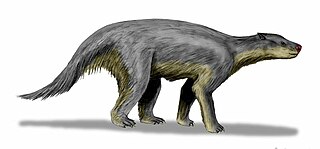
Pantodonta is an extinct suborder of eutherian mammals. These herbivorous mammals were one of the first groups of large mammals to evolve after the end of the Cretaceous. The last pantodonts died out at the end of the Eocene.
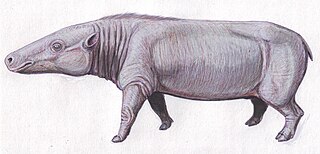
Anthracotheriidae is a paraphyletic family of extinct, hippopotamus-like artiodactyl ungulates related to hippopotamuses and whales. The oldest genus, Elomeryx, first appeared during the middle Eocene in Asia. They thrived in Africa and Eurasia, with a few species ultimately entering North America during the Oligocene. They died out in Europe and Africa during the Miocene, possibly due to a combination of climatic changes and competition with other artiodactyls, including pigs and true hippopotamuses. The youngest genus, Merycopotamus, died out in Asia during the late Pliocene, possibly for the same reasons. The family is named after the first genus discovered, Anthracotherium, which means "coal beast", as the first fossils of it were found in Paleogene-aged coal beds in France. Fossil remains of the anthracothere genus were discovered by the Harvard University and Geological Survey of Pakistan joint research project (Y-GSP) in the well-dated middle and late Miocene deposits of the Pothohar Plateau in northern Pakistan.
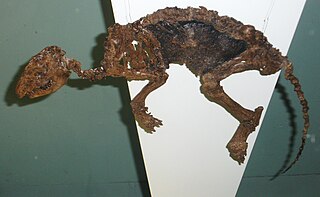
Dichobunidae is an extinct family of basal artiodactyl mammals from the early Eocene to late Oligocene of North America, Europe, and Asia. The Dichobunidae include some of the earliest known artiodactyls, such as Diacodexis.

Protoceratidae is an extinct family of herbivorous North American artiodactyls that lived during the Eocene through Pliocene. While early members of the group were hornless, in later members males developed elaborate cranial oramentation. They are variously allied with Ruminantia or Tylopoda.
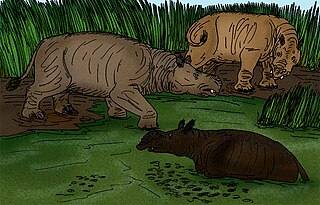
Amynodontidae is a family of extinct perissodactyls related to true rhinoceroses. They are commonly portrayed as semiaquatic hippo-like rhinos but this description only fits members of the Metamynodontini; other groups of amynodonts like the cadurcodontines had more typical ungulate proportions and convergently evolved a tapir-like proboscis.
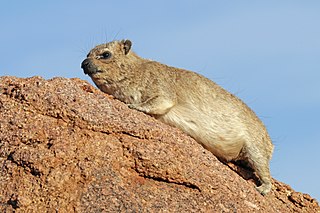
Hyraxes, also called dassies, are small, thickset, herbivorous mammals in the order Hyracoidea. Hyraxes are well-furred, rotund animals with short tails. Typically, they measure between 30 and 70 cm long and weigh between 2 and 5 kg. They are superficially similar to pikas and marmots, but are more closely related to elephants and sea cows.
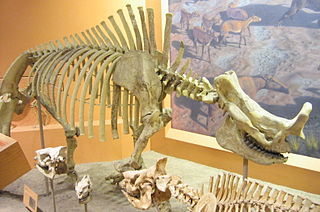
Brontotheriidae is a family of extinct mammals belonging to the order Perissodactyla, the order that includes horses, rhinoceroses, and tapirs. Superficially, they looked rather like rhinos with some developing bony nose horns, and were some of the earliest mammals to have evolved large body sizes. They lived around 56–34 million years ago, until the very close of the Eocene.

Agriochoerus is an extinct genus of scansorial herbivore of the tylopod family Agriochoeridae, endemic to North America. Agriochoerus and other agriochoerids possessed claws, which is rare within Artiodactyla, as well as likely being scansorial. Agriochoerus was first described in 1869.
Leptochoeridae is an extinct family of basal artiodactyl mammals from the early Eocene to late Oligocene of North America.
Sparnotheriodontidae is an enigmatic extinct family of litopterns known primarily from teeth. Sparnotheriodontids are one of two South American native ungulate clades known to have reached Antarctica, the other being astrapotheres.



















